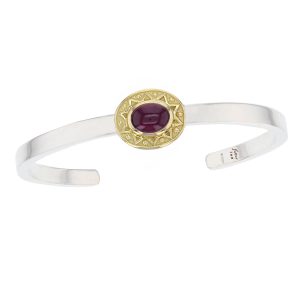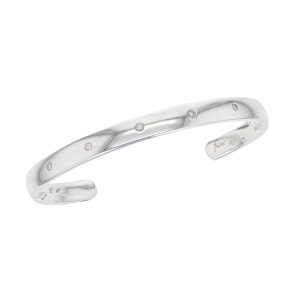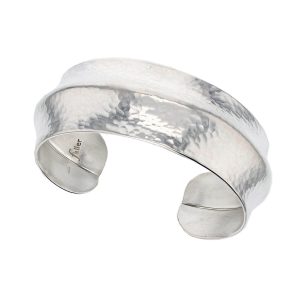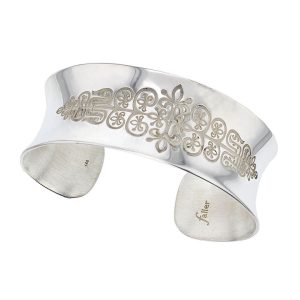The word ‘Bangle’ came from the Hindi word ‘bangri’, which means ring-shaped armlet and dated from 2600 BC when bangles were traditionally made from materials such as bronze, terracotta, seashells and copper.
Wristwear Styles
Round Bangles
Round bangles are made from gold or silver wire with no break or gap, rather like a wedding ring. These bangles have to be larger than the wrist to sllde on over the hand. We recommend that a tight fit over the wrist is best for comfort when wearing.
Round bangles can be made in different profiles such as round, oval or rectangular and in different widths and thicknesses. The round cross-section is ideal for adding charms. Round bangles are made from solid or hollow wire. All Faller round bangles are made from solid wire. The solid silver thicker round bangles are usually worn individually but in thinner styles, multiple bangles can be worn at the same time.
Narrow round bangles are also sometimes called slave bangles. Historically slave bangles functioned as a currency for slave trading. The higher the value of a slave, the more slave bangles were exchanged. These silver and gold bangles were also worn by free woman as a symbol of their husband’s wealth. They could be worn on both the wrist or on the upper arm.
Torc Bangles
Torc bangles, also known as torque or torque bangles are oval in shape with a gap on one side that allows the bangle to be slipped directly on to the arm at the wrist. This means they can have neater, more comfortable fit than round bangles.
Like round bangles, they can be made in different profiles such as round, oval or rectangular and different widths and thicknesses in silver or gold. Torc bangles can also be made from solid or hollow wire but hollow versions are more susceptible to kinking. All Faller round bangles are made from solid wire.
Solid silver torcs are becoming increasingly popular, especially amongst men so they make a great men’s jewellery gift.
Torcs are usually worn singly. Though they are not suitable for adding charms, lots of design variations are possible. Torc bangles can have added detail either on the open ends or the solid side. Celtic torc bangles are particularly popular.
Though widely worn by ancient Egyptians, torcs are most usually identified with Celts and Vikings. Torcs for both wrist and neck made in bronze and gold where popular symbols of wealth and prestige in these cultures. The words “torc” or “torque” comes from Latin and mean to twist or turn something. Typically torc wire was twisted along its length to harden the gold before modern alloys where invented. It was then curved into the oval bangle shape. In thinner torcs, smaller gaps were more common and the bangle had to be twisted apart to put on the wrist. The hardness caused by twisting the wire as it was made allowed the bangle to spring back when released. Modern alloys make silver and gold harder so twisting the wire is no longer necessary and more torc styles are possible.
Cuff Bangles
Cuff bangles are also oval in shape with a gap to slip over the wrist like torc bangles but they are usually wider and made from flattened and shaped gold or silver. Occasionally combinations of metal and leather or woven decorated fabric are also used. The open ends of cuff bangles are usually curved to make putting them on easier.
Like torcs, cuff bangles are also usually worn singly. They can have a huge range of design options with intricate surface pattern or polished and textured finishes. Modern contemporary bangles and traditional Celtic bangles all have there appeal.
Gold or copper cuff bangles were widely worn by both men and women in ancient Egypt. They valued personal adornment highly believing that it pleased their Gods. Gold or iron cuff bangles were also popular with Vikings and Celts.
Bracelets
Unlike rigid bangles, bracelets are flexible and made of silver or gold links, with a catch that allow the wearer to take it on and off. Where the metal links rub against each other the metal can become worn over time. Please check these points periodically as a broken link could mean the loss of a treasured bracelet. Wearing a bracelet too loose increases this wear and tear.
Bracelets are worn on their own creating a look of simplicity and elegance. Chunky silver bracelets and beaded bracelets are perfect for your everyday wear. Delicate, fine chain bracelets and stone set bracelets are more suited to wearing at parties or formal evening occasions.
The bracelet first appeared in Egypt in 5000 BC. They were made in thread, wire, leather etc and beads.















